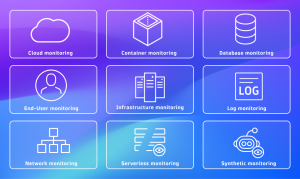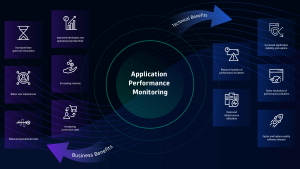Application performance monitoring (APM) means extending monitoring beyond just system availability and service response times. Automatic and intelligent observability of IT systems from infrastructure to the edge helps organizations to deliver exceptional user experiences at the scale of modern computing.
What is APM?
Application performance monitoring (APM) is the practice of tracking key software application performance metrics using monitoring software and telemetry data. Practitioners use APM to ensure system availability, optimize service performance and response times, and improve user experiences.
Research firm Gartner defines APM this way:
“Application performance monitoring is a suite of monitoring software comprising digital experience monitoring (DEM), application discovery, tracing and diagnostics, and purpose-built artificial intelligence for IT operations.”
In today’s digital markets, ensuring an application is always operating at peak performance is essential. The connection between a user’s experience with the back-end services supporting its functions is not always clear, which is especially true with distributed cloud-native applications. To address these ambiguities, APM enhanced by AI greatly increases the efficiency of analyzing application dependencies and how each component affects the other.
APM provides insight into how users experience applications and where performance gaps lie. Mobile apps, websites, and business applications are some examples of front ends that APM can monitor, providing insight into an application’s user experience. APM also includes supporting elements, such as hosts, processes, services, the network, and logs, to foster additional understanding of application performance.
Check out this session from the Perform 2024 conference, “Rationalize tool sprawl and improve service levels with unified observability powered by Dynatrace.”
Application performance monitoring vs. application performance management
In addition to application performance monitoring, APM also stands for application performance management.
While application performance monitoring focuses on specific metrics and measurements, application performance management is the wider discipline of developing and managing an application performance strategy. Both these terms refer to related technology and practices.
Observability vs. monitoring
True to its name, APM is about monitoring application performance and system health by capturing and displaying data that teams then analyze using various means. Monitoring focuses on individual metrics that can indicate specific problems.
Observability, on the other hand, ascertains a system’s internal state based on the data it generates, such as logs, metrics, and traces. With this additional granularity, observability can determine the root cause of problems and realize their effects. Using this telemetry data, observability captures the context of what’s happening across multicloud environments so teams can detect and resolve the underlying causes of issues.
The highly distributed nature of modern cloud environments requires that an effective APM solution take a holistic observability-based approach.
What does APM do?
APM has rapidly expanded to encompass a broad range of capabilities, technologies, and use cases to keep pace with cloud-native IT environments.
Continuous improvement
APM can assist teams in optimizing application performance, reliability, and response times by providing the necessary metrics and data for continuous improvement. By using APM to acquire key data points relating to application performance, such as user interaction patterns, application bottlenecks, and software issues, teams gain a greater understanding of where to concentrate efforts and resources for enhancing applications.
Cloud resource utilization
Moreover, APM assists in managing cloud spend and meeting sustainability goals by identifying where organizations can consolidate and optimize resource utilization and consumption.
Application security
APM also enhances application security, a crucial aspect of preserving business value and delivering secure user experiences, by identifying software vulnerabilities and abnormal or suspicious activities.
AI model performance
Amid the increasing prominence and necessity of AI-driven services, APM can also monitor the performance of AI models embedded in applications. AI model monitoring helps ensure that organizations can predict and control AI costs, performance, and data reliability.
Why do organizations need APM?
Every day, customers use apps to shop, work, stream shows and movies, connect to social media, and manage finances. When an app crashes, is slow to load, or doesn’t load at all, users become frustrated, which can cause the business to suffer brand damage or lose revenue. When an internal business application begins to falter, the company may also see reduced employee productivity.
Discover problems before they disrupt
By monitoring systems at the level of metrics, logs, and traces, an advanced observability-based APM solution can discover problems before they disrupt operations or cause outages. observability metrics can establish a performance baseline and detect variances that could lead to wider problems.
Determine the root cause of issues
If an issue does occur, digital teams often find it difficult to identify the root cause of an application performance problem. Causes can run the gamut, from coding errors to database slowdowns and hosting or network performance issues. Even a conflict with the operating system or the specific device being used to access the app can degrade an application’s performance. Observability-based APM can pinpoint and help teams to prioritize these issues.
Cut through cloud complexity
While modern applications such as mobile apps, websites, and business apps may seem simple on the surface, they’re highly complex. These apps comprise millions of lines of code. They include hundreds of interconnected digital services and open source solutions, and they run in containerized environments hosted across multiple cloud services. Without APM technologies, teams struggle to resolve the numerous problems that can arise, raising the likelihood of customers getting frustrated and abandoning the app altogether.
For this reason, a powerful APM solution based on end-to-end observability is necessary to properly maintain and optimize modern applications.
APM core features
APM encompasses many types of monitoring across the full IT stack, including the following, among others:

- Infrastructure monitoring
- Network monitoring
- Database monitoring
- Log monitoring
- Container monitoring
- Cloud monitoring
- Serverless monitoring
- Synthetic monitoring
- End-user monitoring
Organizations often run dozens of individual monitoring tools at once, especially when they’re holding onto legacy applications and managing them using the tools they find most familiar.
Although individual tools may seem easier, especially to meet the needs of many teams, fragmented monitoring frequently creates problems. A single APM solution that takes a full-stack observability approach makes monitoring all these use cases easy and more reliable.
What are the benefits of APM?
Observability-based APM provides modern IT operations with numerous benefits, including the following.
Full-stack observability
As application infrastructures expand to encompass both on-premises and multicloud environments, organizations increasingly understand that only a full-stack observability approach can deliver comprehensive visibility into the root causes of issues, wherever they originate. Teams can monitor their entire infrastructure from end to end—encompassing everything from infrastructure health to application performance and even the end-user experience. With this visibility, teams can see all these components and understand the interdependencies among them, getting faster answers to key questions.
Continuous automation
Trying to manually maintain, configure, script, and source the volume of data in a cloud-native environment is beyond human capabilities. Therefore, organizations must continuously automate these tasks to ensure proper application performance. Processes including deployment, configuration, discovery, and updates require automation to keep pace with modern multicloud environments and user demands. For this reason, an APM solution that continuously informs and automates every touchpoint of the software development lifecycle (SDLC) and other business processes is crucial to maintaining efficiency.
AI assistance
AI assistance empowers teams by reducing manual or redundant work, allowing them to be more productive in areas of critical importance to the business. An observability-based APM solution that provides multi-tiered AI capabilities goes beyond just collecting data by using that data for real-time answers. A successful APM solution uses predictive, causal, and generative forms of AI in tandem to proactively resolve problems and improve performance without the need for extensive manual effort.
Cross-team collaboration
APM is a team sport, typically requiring the expertise of multiple teams. When organizations can depend on a unified observability-based platform as a single source of truth, teams can break down silos and achieve greater cross-team collaboration. When business, operations, application, and development teams are working from the same data sets, they can streamline communication and reach decisions quickly to resolve problems and optimize applications.
User experience and business impact
User experience is inextricably linked to business outcomes, whether the application is mobile app-to-user, IoT device-to-customers, or a web application behind the scenes. With intelligence into user sessions, including real user monitoring and session replay, teams can connect user experiences to application performance and business outcomes such as increased conversions, revenue, and completed customer journeys.
Synthetic monitoring also enables teams to proactively resolve issues and optimize applications by simulating artificial user interactions, which can ensure optimal user experience before any real issues occur.
With data-backed decisions, answers at the ready, and real-time visibility into user journeys and business key performance indicators (KPIs), organizations can consistently and more efficiently deliver ideal customer experiences across all their channels for better business outcomes.
The technical, operational, and business benefits of APM
APM provides specific benefits for technical, operations, and business teams.

APM technical benefits
Business, operations, application, and development teams can expect several practical benefits from adopting APM practices and tools, including the following:
- Increase application stability and uptime by AI-powered root-cause analysis and real-time answers
- Reduce performance incidents with proactive alerting
- Speed up and automate performance problem resolution
- Accelerate and increase the quality of software releases with automated development and delivery processes
APM operational benefits
Long-time users also report that APM has given their organizations some unexpected but impactful advantages. Operational benefits include the following:
- Increase collaboration across teams with a single source of truth
- Boost confidence to make well-informed and impactful business decisions for teams across the organization with new insights and reliable intelligence
- Increase efficiency and innovation for application, operations, and development teams for faster issue resolution
- Bolster job satisfaction and higher employee retention among team members
APM business benefits
Those in the boardroom have just as much to gain from adopting APM solutions as those on the front lines of DevOps efforts. Business benefits include the following:
- Reduce operational costs with greater automation and efficiency
- Upgrade developer and operational productivity by facilitating cross-team collaboration
- Improve customer experience by increasing understanding of end users and their preferences
- Increase conversion rates from improved application stability and optimized user experience
- Achieve sustainability goals with greater insight into the IT carbon footprint
However, modern cloud-native environments present challenges for APM solutions that require specialized capabilities to achieve these benefits.
Why do cloud-native applications make APM challenging?
Even though the benefits of APM are well established, the rise of complex cloud-native applications has made it more challenging for organizations to perform well and remain competitive.
Massive amount of telemetry data
For example, cloud-native apps generate far greater quantities of telemetry data because they are made up of myriad microservices that dynamically spin up and down in the background. Each of these microservices exists for a short period and generates its own telemetry data, adding to the overall signal noise. When this happens, it becomes more difficult to find the most important events taking place within an application’s infrastructure.
Distributed cloud architectures
What’s more, the distributed and dynamic nature of microservices often makes it difficult to pinpoint the root cause of issues without the assistance of a reliable AI engine. As a result, strong AI capabilities are a necessity for cutting through the noise and garnering meaningful answers relating to problem remediation and application optimization.
Heterogeneous data
Cloud-native apps also produce many kinds of data. Telemetry data from a serverless environment is quite different from a database or a virtual machine (VM), for example. But an organization still needs to centrally manage and make sense of all the information as it comes in.
Increased velocity
The velocity at which systems generate this data is another problem. When a cloud-native app includes many smaller microservices, data comes in at a much faster rate than with a monolithic application. All these factors add challenges that make traditional APM more difficult in a cloud-native application environment.
APM tools vs. APM platforms
Though often referred to as one in the same, both APM tools and APM platforms offer unique benefits that teams can apply based on an organization’s needs, use cases, and resource availability.
What are APM tools?
APM tools are software utilities that often focus on one specific aspect of application performance. Such point solutions can help identify specialized issues. Over time, however, organizations often find themselves using multiple APM tools that don’t necessarily integrate with one another or provide comprehensive insights into the application environment.
In response to the rapid influx of telemetry data, organizations can take one of two approaches when picking APM tools. By default or by design, different teams may deploy a combination of point solutions—tools that solve only one business problem. Conversely, they may choose a single platform that more fully encompasses the many layers and use cases within the application environment.
What is an APM platform?
An APM platform is a software system that provides a single integrated solution using AI and automation to deliver a precise, context-aware analysis of the application environment. Organizations can use an APM platform to continuously monitor the full stack for system degradation and performance anomalies.
With the deluge of telemetry data associated with cloud-native apps comes a profusion of performance monitoring tools and platforms. In response, organizations are turning to open source standards and tools, such as OpenTelemetry, to standardize how they instrument, generate, and collect telemetry data for analysis. However, to thoroughly analyze the data such tools gather, the tools often must be complemented by an observability-based APM platform. This combination can provide valuable insights into software performance and behavior across multiple cloud platforms and tools.
Point solutions can pose benefits at a local level and challenges at a macro level, while a platform approach embraces a modern vision of APM that demonstrates clear advantages at the local and macro levels. What’s more, a platform approach also streamlines and simplifies business and technical processes, enhancing collaboration across teams.
Benefits of individual APM tools
Individual APM tools are specialized to monitor specific components and provide advantages for those specific use cases. For example, some organizations use Grafana to consolidate their metrics visualizations in a single dashboard while others use Jaeger for its distributed tracing capabilities to gain better observability of their systems and troubleshoot performance issues. Both these tools are highly specialized for the environments to which they’re applied.
Teams focused on solving a specific, specialized issue, such as implementing a service mesh to help manage orchestration in their Kubernetes environment, turn to individual tools because they’re cost-effective and easy to implement.
Challenges of individual APM tools
Individual tools only provide a limited view of an organization’s application architecture. This limited visibility makes it harder to identify root causes of application performance issues, resulting in longer downtimes when problems arise. Further, they only provide a single view of the application architecture, often missing the “cause and effect” of performance problems—for example, increased CPU usage caused by a microservice failure. This limited visibility may result in unnecessary troubleshooting exercises and finger-pointing, not to mention wasted time and money.
Because the scope of these solutions is limited, they can also create silos in which teams may disagree on service-level objectives (SLOs) and metrics. This silo effect can lead to more inefficiency and blame-shifting, as teams rely on different sets of information.
APM as part of a larger multicloud observability strategy
Because APM has its roots in the era of monolithic applications before the rise of microservices, open source technologies, and cloud-native environments, some industry observers have argued that APM platforms lack the innovation and deep-dive capabilities required to keep up with bespoke point solutions and individual tools. This may be true for many traditional APM monitoring tools.
However, an observability-based platform such as Dynatrace can offer broad technological coverage across the full stack, including bespoke point solutions.
Purpose-built for cloud-native environments
By leveraging data capture for any type of application and APIs to ingest data, a cloud-native platform like Dynatrace can broaden its coverage to the entire hybrid-multicloud network. This provides a macro-level view across multiple environments to provide continuous discovery. Visibility extends to the applications running within these environments, providing proactive anomaly detection prioritized by business impact.
AI and continuous automation
Crucial capabilities of a modern APM platform include AI and continuous automation. With the explosion of observability data, a platform needs to automatically process billions of dependencies in real-time, continuously monitor the full stack, and deliver precise answers with root-cause determination. Dynatrace takes a power-of-three approach to AI that leverages predictive, causal, and generative AI to help organizations deliver the highest software performance and enable workflow automation.
Integration with cloud platforms
With the scale, diverse functionality, and dynamic nature of cloud platforms such as Amazon Web Services, Microsoft Azure, and Google Cloud Platform, successful APM solutions need to work immediately without configuration or model training. The Dynatrace platform provides complete observability out of the box for dynamic cloud environments, at scale and in context.
By going beyond metrics, logs, and traces with AI-powered analytics, Dynatrace provides automated and intelligent answers from data across the full stack, including entity relationships, user experience data, cloud services, and the latest open source standards, including OpenTelemetry.
Leading vendors in the APM market
Gartner names leading vendors in the APM and observability market in its annual Magic Quadrant report, giving APM users valuable insight into which solutions are best suited to their unique needs. Gartner positions each vendor into various quadrants on a graph, rating them according to their leadership position within the market and their completeness of vision.
Dynatrace was named a Leader in the 2024 Observability Platforms, positioning the company as furthest for Completeness of Vision and highest for Ability to Execute. Dynatrace also ranked No. #1 out of 19 vendors in the 2023 Gartner Critical Capabilities for APM and Observability Report across all six use cases.





Looking for answers?
Start a new discussion or ask for help in our Q&A forum.
Go to forum